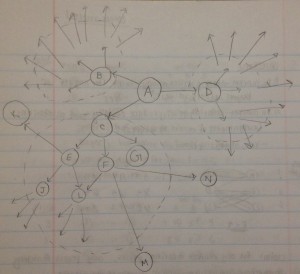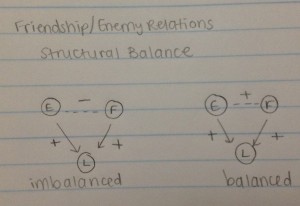Graph Theory and the ALS Ice Bucket Challenge
If you have logged on to Facebook in the past few months, most likely you have seen videos of people dumping buckets of ice water on their heads. The Ice Bucket Challenge, which has been used to promote awareness for ALS (Amyotrophic Lateral Sclerosis), went viral this summer over social media. The idea with the Ice Bucket challenge is that one person makes a video of himself pouring the water on his head, posts it to some social media site, and then nominates three other people to do the same thing in the next 24 hours. The LinkedIn article posted below discusses how the Ice Bucket Challenge is an example of diffusion theory, but I will focus on how it also represents graph theory. It is easy to see that this challenge is an example of an ever-expanding graph.
With the Ice Bucket challenge, the people who participate in it are nodes on the graph. The directed edges in the graph point to the people they nominate. If a person accepts the challenge, the person adds three more directed edges to the graph. If the person does not accept the challenge, then there are no directed edges pointing out from that person’s node on the graph. The graph for the ALS ice bucket challenge can be used to highlight many different principles and ideas of graph theory, including strong and weak ties, strong triadic closure, friendship and enemy relations, and structural imbalance.
As an example, I have drawn a mini graph of the ALS ice bucket challenge. Suppose A is the originator of the challenge, and A is an athlete, a computer science student, and a musician. Suppose A nominates B, a friend on her sports team, C, her CS partner, and D, a friend who plays the same instrument as her. A has now expanded the challenge to three completely different social circles, and those three can now nominate three people in the same social circle, or in different ones. Now, C nominates three people, E, F, and G who are in the same social circle.
In my example, E and F both nominate L, which is highly likely since E and F are in the same social circle. Zooming in on this specific example within the larger graph I have drawn, I can label the directed edges from E to L, and from F to L with a ‘S’ sign to indicate strong ties. Now, there is currently no edge between E and F, but based on the property of strong triadic closure, wherever a node has strong ties to two other nodes, the two other nodes must have an edge between them. So, in order for the graph to not violate strong triadic closure, there must be an edge between E and F. This edge can either be a ‘W’, a weak tie, meaning that E and F are acquaintances, or it can be a strong tie ‘S’, meaning they are friends.
In class we also learned about how graphs can be used to represent friendships and enemy relations. Let’s say that ‘-‘ means that two people are enemies, and ‘+’ means that two people are friends. E and F are obviously both friends with L, so I have labeled those two edges with ‘+’. If the edge between E and F is ‘-‘, then the triangle within the larger graph is imbalanced, because L is friends with two people who are enemies with each other. On the other hand, if the edge is labeled with a ‘+’, then the triangle within the larger graph is balanced.
The only way this challenge can come to an end is if everyone who is nominated does not accept the challenge and does not nominate further. However, the chances of this happening in the near future are slim. The LinkedIn article states that the challenge has gained so much popularity for four main reasons: the innovation, the communication channels, time, and the social system. Out of the many people who are currently nominated and have 24 hours to complete the challenge, the probability indicates that at least one will, in which case the graph continues to expand and raise awareness for the disease. The ALS association is well on its way to reaching the $100 million mark in donations, and the challenge is still going strong.



